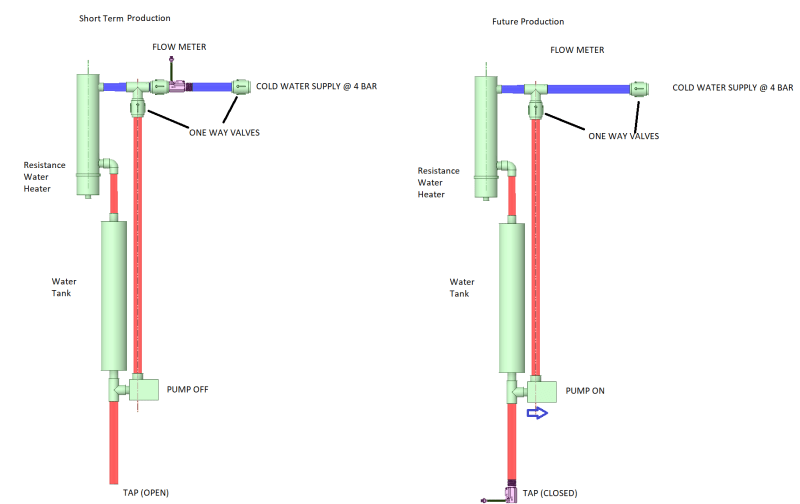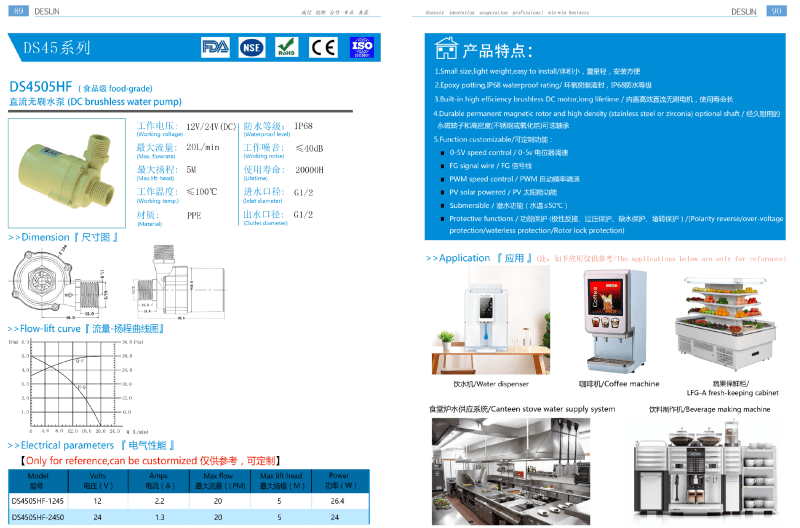Jack Benson
Industrial
I have posted about this system before, but not specifically the problem i am posting about now.
We have a small instant water heater that has a small water thank (1 litre) attached to it.
The water heater is has a volume of about 0.5 litres.
Its for a very specific application.
When we need to use the warm (not hot max 40C) from this system, we press a button that starts a pre-heat cycle where the water heater comes on and a small pump starts, and heats all the water in the water tank and the water heater to 40C.
There are temp sensors to cut the power off to the water heater when ready.
This is the schematic of our system that i have posted before when asking about where to position the flow sensor:

I very very nervous about choosing a pump that would be ok.
We were looking for something 12v, about 20 watts, as we had tested with this power level and it was adequate for our needs.
I was discussing with various suppliers in China and settled on this pump after lengthy discussions with them (they did pressure tests / temp tests for me).

This is a link to the full manual: Link
We got the delivery about a month ago, and it was working well in our test environment.
This week we got a new sample PCB and instead of the temperature maxing out at before 40C, it was going to about 45C. This is a bug that will be fixed.
The problem was that the pump developed a leak on one of the screw threads (see video): Link
I found it very difficult to source this part and it was the item that i was most worried about when sourcing.
I was able to find something suitable in the EU market to benchmark the specification.
I do not know if the issue here is the water pressure (max 4-bar) or the increase in temperature or that that the pump is just not suitable for our application (which i worry is the most probable).
I realised that I do not have the specific material the pump is made from in my file so I have asked for the information.
I should be able to limit the pre-heat temp to 35 C but i do not want to have a part that is prone to failure in the system.
Your insight is always appreciated.
We have a small instant water heater that has a small water thank (1 litre) attached to it.
The water heater is has a volume of about 0.5 litres.
Its for a very specific application.
When we need to use the warm (not hot max 40C) from this system, we press a button that starts a pre-heat cycle where the water heater comes on and a small pump starts, and heats all the water in the water tank and the water heater to 40C.
There are temp sensors to cut the power off to the water heater when ready.
This is the schematic of our system that i have posted before when asking about where to position the flow sensor:

I very very nervous about choosing a pump that would be ok.
We were looking for something 12v, about 20 watts, as we had tested with this power level and it was adequate for our needs.
I was discussing with various suppliers in China and settled on this pump after lengthy discussions with them (they did pressure tests / temp tests for me).

This is a link to the full manual: Link
We got the delivery about a month ago, and it was working well in our test environment.
This week we got a new sample PCB and instead of the temperature maxing out at before 40C, it was going to about 45C. This is a bug that will be fixed.
The problem was that the pump developed a leak on one of the screw threads (see video): Link
I found it very difficult to source this part and it was the item that i was most worried about when sourcing.
I was able to find something suitable in the EU market to benchmark the specification.
I do not know if the issue here is the water pressure (max 4-bar) or the increase in temperature or that that the pump is just not suitable for our application (which i worry is the most probable).
I realised that I do not have the specific material the pump is made from in my file so I have asked for the information.
I should be able to limit the pre-heat temp to 35 C but i do not want to have a part that is prone to failure in the system.
Your insight is always appreciated.
